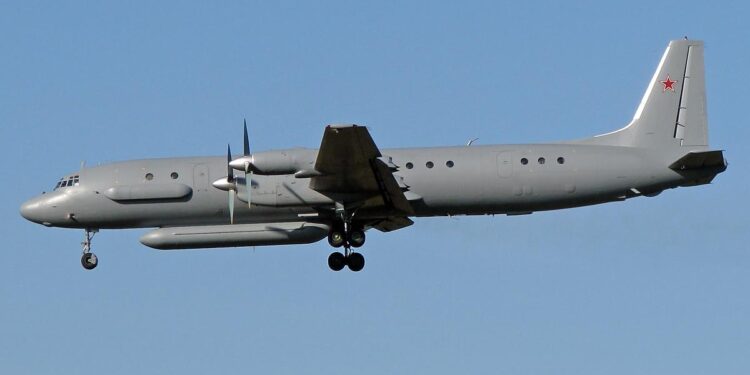Intensified Russian Il-20 Surveillance Flights Over Belarus: A Strategic Shift
In the midst of ongoing instability in Eastern Europe, intelligence reports indicate a marked increase in Russian reconnaissance operations utilizing Il-20 electronic surveillance aircraft within Belarusian airspace. These flights are primarily aimed at collecting comprehensive data on Ukrainian air defense radar systems. Defense analysts note that this escalation aligns with Ukraine’s efforts to bolster its military defenses amid mounting Russian pressure. The Il-20, equipped with sophisticated electronic intelligence (ELINT) technology and capable of extended missions, remains a critical asset for gathering battlefield information that shapes strategic military decisions.
Belarus‚Äôs role as a forward operating base for these missions highlights the region’s geopolitical importance and illustrates how neighboring states are deeply enmeshed in this complex security landscape. The deployment of such advanced reconnaissance platforms signals an evolution in warfare where control over information is increasingly pivotal alongside traditional combat capabilities.
Strategic Goals Behind Russia’s Il-20 Reconnaissance Operations
The surge in Il-20 flights over Belarus serves several key functions within Russia’s broader military strategy:
- Detailed Radar Network Analysis: Mapping and cataloging Ukrainian radar installations and missile defense arrays, identifying potential weak points.
- Electronic Signal Interception: Monitoring emissions from Ukraine’s air defense systems to assess their operational status and response behaviors.
- Tactical Intelligence Support: Providing commanders with real-time situational updates to enhance decision-making during active engagements.
This intensified surveillance is integrated into larger-scale exercises designed not only to validate operational readiness but also to assert dominance over contested aerial zones. It underscores an uptick in intelligence-gathering activities amid escalating tensions between Moscow and Kyiv, with Belarus serving as a crucial logistical hub.
The Impact on Ukrainian Air Defenses and Regional Security Balance
The deployment of Russian Il-20 ELINT aircraft near Ukraine’s borders represents a significant intensification of espionage efforts aimed at weakening Kyiv’s defensive infrastructure. By persistently tracking radar signals, Moscow gains valuable insights into vulnerabilities within Ukraine‚Äôs layered air defense network‚ÄĒinformation that could be exploited during future offensive or electronic warfare operations.
- Diminished Defensive Reliability: Continuous detection by the IL-20 may compel Ukraine to modify or temporarily deactivate certain radar sites, potentially creating coverage gaps.
- Pursuit of Enhanced Countermeasures: In response, Ukrainian forces are accelerating development of mobile air defense units alongside advanced jamming technologies intended to disrupt enemy reconnaissance capabilities effectively.
The conflict has also spurred increased Western assistance through deliveries of state-of-the-art anti-aircraft systems‚ÄĒsuch as Norway-supplied NASAMS batteries‚ÄĒand expanded training programs focused on improving resilience against electronic interference. These initiatives contribute to an ongoing arms race centered around achieving aerial superiority that will influence both current hostilities and long-term regional security frameworks.
| Main Drivers | Aimed Outcomes |
|---|---|
| NATO & Western Military Assistance | Sustained delivery of cutting-edge surface-to-air missile platforms enhancing Ukrainian defensive posture |
| Tactical Adaptations by Ukrainian Forces | Diversified deployment tactics increasing survivability against ELINT threats |
| Moscow’s Electronic Warfare Advancements | Evolving signal jamming methods targeting command-and-control infrastructures |
Tactics for Enhancing Radar Defense & Counterintelligence Measures
The rise in Russian surveillance activity demands comprehensive counterstrategies combining technological innovation with refined operational procedures across all levels responsible for protecting national airspace. Essential steps include:
- Upgrading Radar Systems: Introducing next-generation integrated radars capable not only of detecting but swiftly classifying stealthy reconnaissance assets like the Il-20;
- Cybersecurity Strengthening: Establishing robust cybersecurity protocols specifically designed to shield sensor networks from cyber intrusions or signal tampering;
- NATO Intelligence Sharing Enhancement: Pursuing deeper real-time collaboration among allied nations facilitates faster threat identification coupled with coordinated responses;
- Sustained Training Programs: Regular simulation drills replicating adversary ISR (Intelligence Surveillance Reconnaissance) techniques ensure personnel remain adept under high-pressure scenarios;
- < li >Deploymentof aerial decoys engineeredto mimic authentic emitters , confusing enemy sensors ;< / li >
< li >Dedicated SIGINT (Signal Intelligence) resources taskedwith intercepting hostile communications linkedto airborne surveillance ;< / li >
< li >AI-driven analytics processing vast electromagnetic spectrum data streams instantaneously , enabling automated defensive reactions .< / li >
Aerial Intelligence Operations Shaping Eastern Europe’s Security Landscape: Closing Reflections
The persistent useofRussianIl – 20spyplanesoperatingfromBelarusnotonlyreflectsthe heightened tensionsbutalsoemphasizesthevitalimportanceofairborneintelligencesurveillancein contemporaryconflicts.AsUkrainecontinuesadaptingitsdefensesandNATOscrutinizesregional developments,thedelicatebalancebetweenoffensiveanddefensivemoveshingesonadvancesinreconnaissancetechnologyandcountermeasures alike.The evolving situation requires vigilant monitoringastheseactivitiesmayreshapebothmilitarystrategiesandgeopolitical alliancesacrossEasternEuropeinthecomingmonths.Withnoimmediateresolutioninsight,the imperativeformaintainingairdominanceandsafeguardingcriticalinfrastructureisparamountforall stakeholders involved.Recent NATO reinforcements including F -35 fighter deployments further highlight commitments toward regional stability .< /a >
















